Mac's Believe It or Not!
by John McDougald
Reprinted from "Crown Jewels of the Wire", December 2001, page 33
UNBELIEVABLE INSTALLATION: Inside a substation in Illinois, linemen found
installed over 50 of the carnival CD 233 Pyrex insulators using only twine to
attach the 4-ought copper wire. Installers then coated the twine with shellac to
seal the connection.
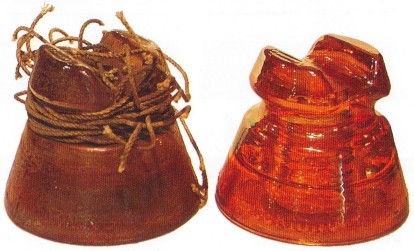
A PENNY FOR YOUR THOUGHTS: This CD 155 Armstrong has a penny molded into the
glass that surrounds the pinhole. Part of the threading of the pinhole was
broken out when the mandrel was dropped into the mold. Part of the actual penny
is visible, but is securely wedged into the pinhole glass.
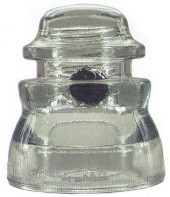
PRIVY PRIZE: A CD 145.6 Boston Bottle Works in rootbeer amber
was dug in Michigan.
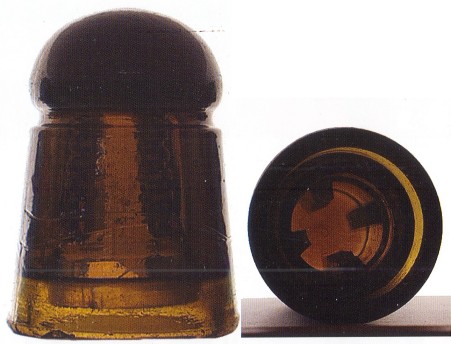
SEEDIEST: A CD 134 American Insulator Company and an unembossed CD 149.
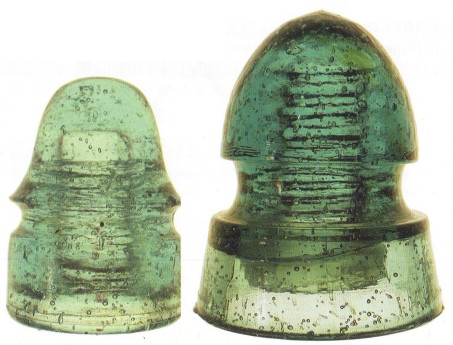
EAST COAST GEMS
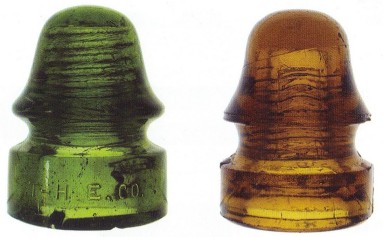
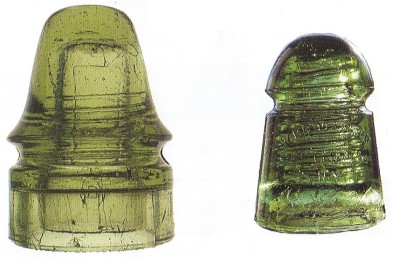
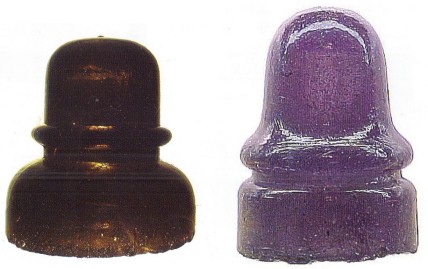
BEAUTY CONTESTANT: M-2636 unmarked with turquoise glaze, a product of Lima
Porcelain.
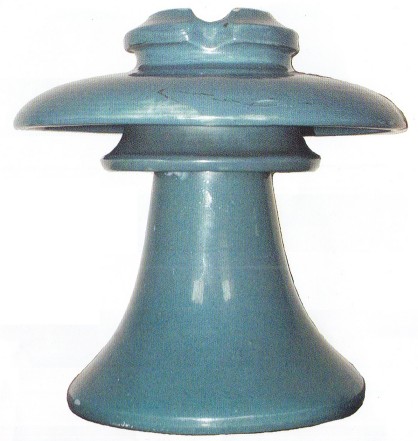
LIGHTNING STRIKES: Some nice colors of lightning rod insulators including an
small amber style, milky olive green and milky purple saddle styles, and a
cobalt sidetab.
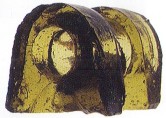
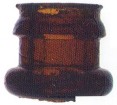
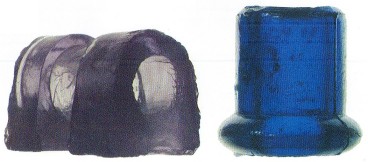
One aspect of this hobby that Mrs. Mac and I really enjoy, is traveling.
And, on most trips, we have been fortunate to have been able to attend
insulators shows/swap meets and stop to see the collections of many collectors
across the country.
What often happens, Believe It Or Not!, is we take pictures
and haven't had the opportunity to share with you some of the really neat pieces
and stories we have heard.
This month's column features one of three Mac s
Believe It Or Not! full color articles that will be appearing in this issue and
upcoming months.
Unbelievable Installation: Jim Crandall brought this unusual carnival CD 233,
still coated with grime and laced with twine to the 2000 national show in
Minnesota. Jim was able to remove at least this specimen from a substation where
he discovered their installation. Upon return to the cache at a later time, he
found that all the pieces had been broken. Thank goodness, he was able to
salvage an example!
A Penny For Your Thoughts: Mrs. Mac saw this piece on Rick Soller's table at
the Eastern Regional show in Corning, New York in the fall of 2000. One would
have thought that the penny would have caused an internal fracture upon cooling,
but this one survived.
Privy Prize: Out of the "bottle works" of an old privy in
Ypsilanti, Michigan, Ernie Griffin shared this CD 145.6 Boston Bottle Works in
rootbeer amber which had surfaced as a "show and tell" item at the
Huron Valley Bottle and Insulator Club's March 2001 meeting. A little light
tumbling restored the luster of this rare, historic insulator. Believe It or
Not!, I only live 350 miles from HVBIC headquarters, but had to fly to the
Cayucos, California show to see it in person for the first time! Butch and
Eloise Haltman are the proud owners now.
Seediest: Bob Fuqua, lucky enough to be a telephone lineman when early New
England pickings and change-outs were commonplace, has put together a wonderful
collection of "things I picked myself' that include the CD 134 American and
an unembossed CD 149. Mark Lauckner (CJOW, July 2000) indicated "tiny
'seed' bubbles are the result of incomplete glass ingredient melting. The alkali
which dissolves the silica in the melting action creates small gas bubbles.
These bubbles take a long time to rise to the surface and pop, and usually
become suspended in the molten glass." I know Bob is glad the glass house
was in a hurry to produce these neat pieces!
East Coast Gems: Regional collectors tend to fall in love with
"local" insulators. Shown here is a dark yellow-green CD 134 T-HE CO.
signal; an honey amber CD 134.4 (Oakman product); a CD 160.7 American Insulator
Co. "snow cone" in light olive green; a CD 104 Brookfield in yellow,
olive color; a brown amber CD 740.3; and a CD 726 in purple.
Believe It Or Not!
the color of the CD 740.3 (owned by Alan Klapaska) is not visible until you
shine a bright light from underneath. Adam Hamel picked up the CD 104 Brookfield
in an eBay auction and Bob Fuqua just "picked" the T-HE CO. signal!
When the CD 726 in purple appeared at the Yankee Pole Cat Insulator Club show
last spring, Ross Baird (now how did a Texan fall in love with East Coast
glass?) made an offer to the gentleman from New Hampshire that had found the
piece at a yard sale. It was not for sale. The following month, Mrs. Mac was in
Texas at an insulator show and stopped to see Ross's collection. There sat the
CD 726 in purple on his display shelves! Seems the gentleman reconsidered and
accepted the offer Ross had made. Now, here is the Believe It Or Not! part
-- In May, Mrs. Mac and I flew to California to attend the Cayucos show in
California, then drove to Oregon for the Western Regional. Along the way, we
stopped to visit Paul and Kathy Greaves. Paul does a great job of repairing
insulators and stabilizing internal fractures in glass. "Let me show you
a neat insulator I am working on right now," Paul said. There, receiving a
fracture treatment, was the purple CD 726. Saw it first in Connecticut, next in
Texas and then in California. Not sure who travels more, Mrs. Mac or Mr. Purple
726!?!
Beauty Contestant: As the story goes, Believe It Or Not! . . . a collector
found a group of porcelain insulators owned by a local beautician. In the back
of the shop, the collector was led to a room where there were a lot of porcelain
pieces. The non-collector stated that she thought they are all
"painted", but would take $100 for the lot. "How 'bout I give you
$100 for just five?" That worked.
Lightning Strikes: If this is the first time you have seen lightning rod
insulators, you will have to agree they are small and beautiful.
Watch for more color rarities in upcoming issues, Believe It Or Not!
On to the new finds of the fall. . .
The Consolidated Design system developed by N.R. "Woody" Woodward
has proven to be invaluable in having consistency in describing styles of
insulators. It is the language of our hobby. And, Woody has always been willing
to look at "new vocabulary" as insulators are introduced to him. Such
was the case at the recent Springfield, Ohio show last month.
Preparing to leave for the show, I had Mrs. Mac take along an
insulator that I had always wondered about, as far as its CD assignment was
concerned.
The PATENT - DEC. 19, 1871 listing under CD 104 looked like it might be a candidate for new listing, but in order to be sure I thought it was
important to take the actual piece to show Woody in person.
Most CD
designations, when one or more manufacture is represented, can demonstrate a
grand array of mold designs. Even when only ONE manufacture is involved
variations occur. And, the CD system is one that makes room for variations even
when only one drawing is presented to represent the assignment.

For example,
here are some Brookfield CD 104s which can vary in shape according to the time
in which their manufacture took place and the molds that were typical of that
era.
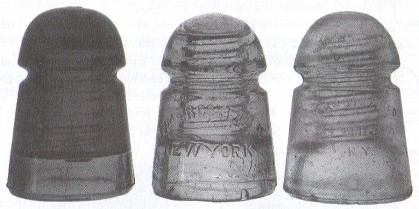
[010] (Arc) BROOKFIELD/NEW YORK, emerald green
[050] (Arc) WM
BROOKFIELD/NEW
YORK, lime green
[020] (Arc) W. BROOKFIELD/45 CLlFFST/N.Y.. aqua
And, within the CD 104 made for New England Telephone and Telegraph Company,
there are multiple variations.
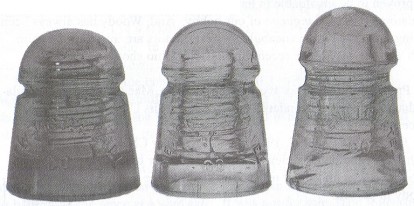
From a short, squatty version (on the left); a more "typical" style
piece (middle); to one that looks very elongated (right).
The PATENT-DEC. 19 1871 piece (assigned CD 104) was one of Hemingray's early
"No.4" styles. CDs 124, 124.2, 124.3 were assigned and drawn, and I
have always questioned why the CD 104 might have been assigned "out of the
sequence" of the other "old 4's." Even the CD 124.5, known as the
"winged Chambers companion" is embossed with the "4" on the
dome and looks like it might have been a rework of an old CD 124.3 mold.
At the
last minute, I had Mrs. Mac pack a CD 104 and a CD 124.2 "old Hemingray
4." On Friday afternoon, Mrs. Mac showed Woody both pieces. And, after
careful study, he said he thought it should probably receive a new CD and he
would consult his paperwork back in Houston upon his arrival home and drop me a
note. He thought that he might never have seen an actual specimen of the
"old 4" before now.
With much excitement, Mrs. Mac shared with Bill
and Jill ("M/M Hemingray") Meier that she was hopeful there might be a
new Hemingray CD assigned very soon. Bill said, he thought he might get a new
one assigned on Saturday. That "I'll tell you, if you tell me" look
came over everyone's eyes.
Believe It Or Not! Bill and Jill had brought along an assortment of CD 104s
and the CD 104 Patent - Dec. 19 1871 from their collection. Sure enough, like
minds. . .
After checking his paperwork in Houston, N.R. "Woody"
Woodward send along the following new CD assignment. . .
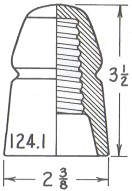 |
 |
| New CD 124.1 showing the
front dome embossing, PATENT / DEC. 19, 1871 and
rear dome embossing: 4 |
Another interesting item looking for a "name" was a sleeve that is
embossed BROOKFIELD on the skirt. This piece recently surfaced in an old Ohio
collection where it had resided for nearly 30 years. The sleeve was dug in the
New Philadelphia area of the state along with a threadless hat. Neither piece
had been to an insulator show for many years.
The sleeve is severely fractured
internally and has not been reglued. With N.R. Woodward, Elton Gish and Jim
Fruistieri coming to the Springfield, Ohio show, this was the time to get some
opinions.
Brookfield's 1912 catalog (see page 52 for ordering information) shows
glass multiparts. Jim Fruistieri's display had the only known example of a CD
338. Most of the sleeve has been reconstructed according to the dimensions shown
in the Brookfield catalogue. The CD 338 is embossed BROOKFIELD on the top of one
ear.
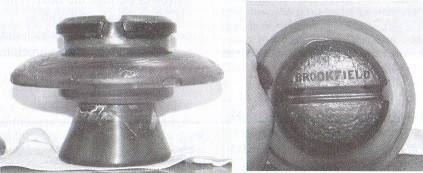
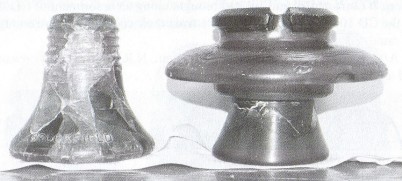
The sleeve embossed BROOKFIELD (left) measures 4-5/8" across the base and
stands 4-1/2" tall. It most closely resembles the measurements of the CD
347 as pictured. Reports of other pieces of sleeves embossed with the full name
BROOKFIELD have come from those who searched the Brookfield dumps on the east
coast, but this is the first complete sleeve to have been reported and the only
existing part of a CD 347.
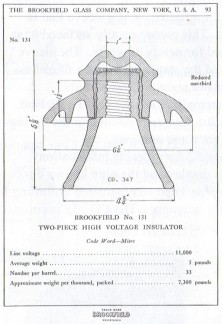
Elton Gish documents the use of glass
sleeves in his book, Fred M. Locke. A Biography.
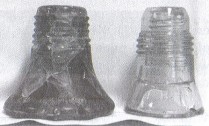
Jim Frustieri had a sleeve in his display that had only the letter
"B" embossed on the skirt.
It was similar in height to the
Brookfield-embossed sleeve, but narrower through the skirt. This "B"
sleeve was used with a porcelain top (U-942) which did not have threads in the
porcelain shell. Instead it had a large opening which measured 2-3/4" with
five grooves around the inside to make a better cementing surface when joined
with a glass shell, Believe It Or Not!
| 